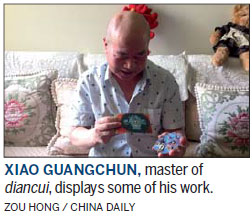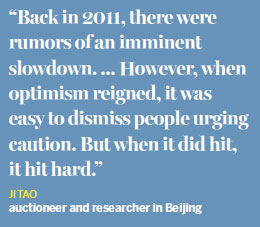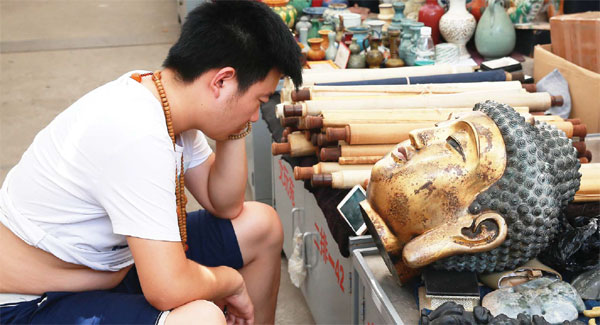Market leaves antiques dealers on the shelf

Having lived off his "feathery art" for more than four decades, attending to the needs of a select band of customers from his private workshop, Xiao Guangchun has finally decided to open a public workspace in a business center in eastern Beijing.
The craft the 60-something diligently learned, painstakingly practiced and now jealously guards from everyone except his children is called diancui, which means "dipping blue", and involves applying kingfisher feathers to the surfaces of gold jewelry.
The technique has been employed for centuries, especially to add a dash of shimmering blue or indigo to the gold and gilt silver accessories that adorned the ladies of the imperial court.

| Top from left: A vendor stares into space at Panjiayuan, Beijing's biggest antiques market. Stalls at Panjiayuan. Foreign visitors assess the wares at Panjiayuan; Above: A customerless vendor watches a video on his smartphone. Photos by Zou Hong / China Daily |
"Antique collectors and dealers from both in and outside China came to me. For many years, I just bent over my work desk," he says. Commissions kept flooding in, and apart from fulfilling them, all he had to do was to raise his prices from time to time.
"My clients seldom complained," says Xiao, who used to charge about 10,000 yuan ($1,500; 1,350 euros) to turn a pair of antique gold earrings - sometimes unearthed with the diancui having rotted away - into a lustrous piece worthy of a national museum.
However, a few years ago, the antique market entered a prolonged downward spiral from which it has yet to recover. The spate of orders Xiao had enjoyed dwindled to a thin stream before becoming sporadic. Now, he charges less for his expertise, but he declined to provide his exact prices.
"Before, I was sought out by eager clients, but now we need more visibility, and therefore a workshop in a business center," he says, referring to him and his daughter, whose mastery of her newly acquired skills is still shaky.
According to Ji Tao, an auctioneer and researcher in Beijing, the collapse of the stock market in the second half of 2014 dealt a near-fatal blow to the auction market. The number of auctions held in Beijing in 2014 fell by 20 percent compared with the year before.
The number fell by another 30 to 40 percent last year. Some medium-sized auction houses canceled or postponed their spring sales, and others proposed share transfers.
Guardian Auctions, one of China's biggest auction houses, reports that it had 5,800 items in its 2015 spring fair, down 12 percent from the previous year. Beijing Council International Auction also says it organized only 18 sales during the 2015 spring season, half of the number in 2014.

Ji had not only witnessed but also participated as China's art and antiques market reveled in an unprecedented upsurge in the spring of 2011. "There were a lot of people and a lot of carousing," he recalls. "Anything that appeared at auction sold quickly, sometimes at jaw-dropping prices."
The high was followed by a low as the bubble burst in the autumn that same year. Five years later, dealers are still waiting for it to rebound.
"The previous spell of gloom arrived in about 2006 and lasted for three years before things started to pick up in the spring of 2009. Now, five years have passed (since the start of the last market decline), and we're still hoping," Ji says.
"Back in 2011, there were rumors of an imminent slowdown because market fluctuation is a cyclical thing that is bound to happen every two or three years. However, when optimism reigned, it was easy to dismiss people urging caution. But when it did hit, it hit hard."
Among the hardest hit were people he describes as short-term investors - those with scant knowledge who had entered the booming market between 2009 and 2011 in search of quick profits.
"Driven by lust for money, some of them did make a fortune by simply letting a collectible piece change hands, but many more found themselves stranded with tens or even hundreds of thousands worth of stock when the wave began to fall," he says.
"They weren't real connoisseurs, and therefore they could not tell really good pieces from all the mediocre stuff that flooded the market at one time. When anything could sell, their stuff sold. When the economy went down, they went down with it."
Another affected group is at the other end of the spectrum - people who trade petty antiques, have no brick and mortar stores and travel from city to city to attend open-air bazaars.
Xu Qing at the state-owned Henan Provincial Antiques Store in Zhengzhou, Henan province, believes the market meltdown has pushed those people further to the fringes, where they are struggling for a foothold. "For them, the issue is not one of business, but of survival," he says.
The biannual Zhengzhou Antiques Fair used to be one of the biggest events for grassroots traders. It usually ran for four or five days, as people from all over the country checked into the four major hotels near Xu's store. The fair was one of the annual high points for dealers and customers.
"Every hotel door was open, with all the stuff lying on the beds," Ji recalls. "People could just walk in for a closer look. Some eager buyers literally ran from door to door, trying to clinch a deal before others did.
"The event, although far from being high-end, is a barometer of China's antiques market at its base level. This spring, the fair's participants barely filled one hotel."
However, not everyone was hit equally hard, and some people escaped relatively unscathed. "They include the people who bought the 'cream', those who collected at the very top of the antiques-trading pyramid," Ji says. "The value and rarity of those precious items means they will easily weather the current market storm, only to become more sought-after in years to come."

This is where he believes the biggest misconceptions about collecting lie among nonprofessionals. "It would be naive for anyone to equate buying any old antique with collecting and, therefore, investing. Some things may be genuinely old - for example, a little silver hairpin from 100 years ago - but there are so many of them that they have ceased to have any real value as collectible pieces," he says. "Like any other area of investment, only wealth can produce wealth. It's perfectly OK to buy a little silver hairpin for personal appreciation, but don't have any illusions when it comes to returns."
Yang Zhenbin at the state-owned Suzhou Municipal Antiques Store in Jiangsu province believes the market downturn has had a sifting effect, which will result in credible dealers eventually surfacing as winners.
"Like all state-owned antiques stores with a long history, we ensure the authenticity of our merchandise - something that discerning clients definitely appreciate," he says, referring to the crowds that turned up at an antiques fair the store organized in the city on June 30 and July 1.
Wang Ge, an antiques dealer who recently opened a store in Beijing, says the overheated market needed to have a metaphorical bucket of ice poured over it. "People's sense can only be restored once they started to lose money," he says. "I'm not saying that people should stop buying - just try to buy things you love so much that selling is not a priority."
For Xiao, who in 2013 was officially named a master of China's intangible cultural heritage by the Beijing city government, the market turmoil has disrupted the peace of mind that's so essential to the practice of his art.
"People should understand that so many concentrated hours of work deserve a handsome financial reward," he says.
(China Daily European Weekly 08/12/2016 page1)
Today's Top News
- Xi stresses improving long-term mechanisms for cyberspace governance
- Experts share ideas on advancing human rights
- Japan PM's remarks on Taiwan send severely wrong signal
- Key steps to boost RMB's intl standing highlighted
- Sustained fight against corruption urged
- Xi calls for promotion of spirit of volunteerism































